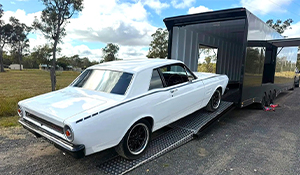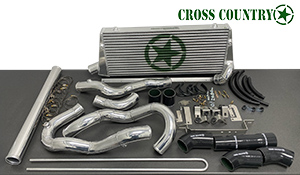How To: Beach Driving
Words Dean Mellor

Cruising along the coast and carving up sand dunes might sound like a lot of fun but there are some important rules to abide by when driving on the beach. In fact, driving in sand can present some of the greatest challenges to four-wheel drivers, as well as place more strain on your vehicle than just about any other surface.
Before you turn off the blacktop, make sure you know the rules for the area in which you’re driving (yes, most beaches have speed limits) and set up your vehicle for the task at hand.

Permits and rules
The first thing you need to check before driving along a beach is if vehicular access is allowed and, if so, if any permits are required. If you live in Victoria, you’ll have to cross a border to drive on the beach, as no beaches in that state allow 4x4 vehicle access. Fortunately, there are plenty of beaches in other parts of Australia that allow beach access.
If a permit is required to access the beach in a 4x4, there will usually be signage at the entry points. If no permits are required, there will often be signage outlining the rules for driving on a particular beach, including speed limits and out of bounds areas. If a permit is required, this information is often supplied to beachgoers when purchase their permit, or it will be printed somewhere on the permit itself or accompanying documentation.
Out of bounds area often include dunes, culturally sensitive areas and vegetated areas, so make sure follow all signage and read any information on a permit thoroughly.
Many beaches will have a 60km/h speed limit, and when confronted by oncoming traffic you should keep to the left as you would on the road, and give way to other vehicles when required. Some beaches will require your vehicle to be fitted with a sand flag so it’s easier to spot when traversing sand dunes and beach access tracks. And remember, as well as sharing the beach with other four-wheel drivers, there’s a strong possibility that there will be people fishing, kids playing and pets running on many beaches, so always drive with due diligence.
Finally, when driving on a beach you’re driving on public land, so make sure you adhere to the relevant state blood/alcohol limits.

Vehicle set-up
Everyone knows you need to drop your tyre pressures to drive on soft sand (well, almost everyone), but how low should you go?
The idea behind lowering tyre pressures is it creates a longer footprint that helps the tyre to float over the surface of the sand rather than cut through it. The correct pressure will depend on the vehicle you’re driving, the load it’s carrying and just how soft the sand is. As a general guide, try dropping pressures to around 24psi and see how the vehicle performs. If you find the going tough, or you get stuck, you can lower the tyres to around 16psi.
You really wouldn’t want to go much lower than 16psi or there’s a real chance of a tyre peeling off a rim and completely deflating. Deflating tyres is much easier (and faster) with a dedicated tyre deflator, and you’ll need an air compressor to reinflate them once you’re off the beach. You’ll also need a quality air pressure gauge.
There are several other checks to make before driving on the beach. Make sure you have enough fuel for the distance you intend to travel and remember that fuel usage will be significantly higher when driving in sand than on the road (up to tice as much). Check all engine/transmission fluids, such as coolant and oils, as your vehicle will be working much harder on the beach than it does on the road. Make sure your UHF radio is on so you can communicate with other drivers on the beach. And make sure you’re carrying all the recovery gear you might need if you get stuck, including shovel, sand tracks, snatch straps, shackles and, if driving solo, winch.


Driving techniques
The key to driving on the beach is to keep the power on, keep momentum up and don’t make any sudden changes of direction or brake abruptly.
Choosing the right gear in a manual transmission vehicle is critical. Start in low-range second and work your way up through the gears until you find a happy medium. If you find the engine is revving too hard, pull up on a nice firm spot and shift back into high range and give that a go. If your vehicle has an automatic transmission, you can run it in drive, but you’ll still have to choose between high and low ratios depending on the conditions.
If the sand is soft you’ll need to use a surprising amount of throttle to keep momentum up, and if the vehicle feels as though it’s bogging down you may need to seesaw the steering wheel back and forth to help the tyres get some bite. Once you have built up enough momentum again, keep it going until you’re out of the soft stuff.
Don’t make sudden changes of direction; remember, your tyres could be as low as 16psi and if you try to turn too sharply they could peel off the rims. In very soft sand, there’s also the chance that the tyres could ‘dig in’, resulting in a rollover situation.


If you’re driving in dunes, learning how to read the sand is important. On sunny days you’ll be able to easily spot where the sand rises and falls thanks to shadows, but this can be much trickier when it’s overcast and there are no shadows. If you’re unsure of the terrain ahead of you, slow down as much as possible, or pull up and scout around on foot.
Driving down steep sand dunes can be both fun and intimidating. Ease your way to the crest of the dune, select low second, drive over the edge and then don’t touch the throttle or the brake pedal; gravity will do the job. Before you reach the base of the dune, start to accelerate, as this is where the sand can be at its softest.
You might need a run up to successfully climb some bigger dunes. As Scotty said, ‘give it all she’s got’ and you’ll have the best chance of making a successful ascent. If you don’t think you’re going to make it, you’re often better off coming to a standstill and then reversing back down the dune to have another crack rather than trying to turn left or right. Attempting to traverse a dune like this is fraught with danger and you could end up on your roof.


Back down at the beachfront, you’ll need to be aware of the tidal situation. Is the water out or in? And is it on its way out or in? If you need to make a run up a thin stretch of beach that’s underwater at high tide, only do so when the tide is going out… or there’s plenty of time available before the beach is again submerged. You really don’t want to be one of those people who lose their vehicle to a rising tide – it’s expensive, embarrassing and a lot of hard work for those who have to recover the wreck.
Don’t drive in salt water. It will completely ruin your vehicle.
Once off the beach, don’t forget to reinflate your tyres and do a general check around for damage. Have a look underneath your vehicle to make sure there are sticks or other debris stuck under there and check to see of splash guards, bash plates, mud flaps and other components are all secure and where they’re meant to be.
Finally, make sure you enjoy yourself. After all, how often do you get to spend a day at the beach?












